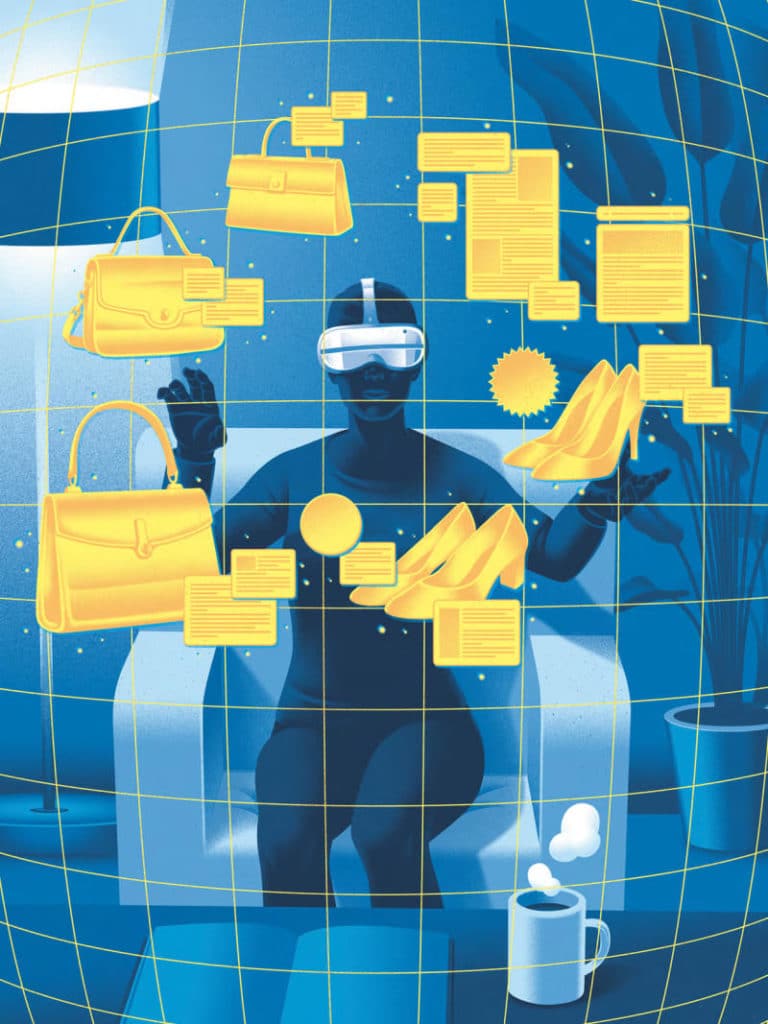Agar sun'iy intellekt (AI) kelajagi tez o'zgaruvchan landshaftdek tuyulsa, bu sun'iy intellekt sohasidagi hozirgi innovatsiyalar shunchalik tez sur'atlar bilan tezlashayotgani sababli, uni ushlab turish qiyin. Aftidan, sun'iy intellekt dunyoni o'zgartirishda davom etadi." Texnologiya jurnalisti Maykl Tomas bu so'zlarni yozganidan beri 12 oy ichida ham o'zgarishlar sur'ati tezlashdi, hukumatlar AI xavfini jiddiy qabul qila boshladilar va chatbotlar virusga aylana boshladilar. Va, albatta, muhim o'zgarishlar bo'lgan joyda Aigloniyaliklar ham bor.
"2000-yillarda Stiven B Jonsonning "Interfeys madaniyati" kitobida o'sha o'n yillikdagi hunarmandlar dasturiy ta'minot muhandislari va mahsulot dizaynerlari bo'lishlarini ta'kidlagan edi", deydi Narain Jashanmal (Alpina, 1997), hozirda MUBI striming xizmatida mahsulot bo'yicha vitse-prezidenti. “Menimcha, u joyida edi. Kod yoki mahsulot dizayni bilan nima qilishingiz mumkin bo'lsa, siz kamera, qalam yoki bo'yoq cho'tkasi bilan qila oladigan narsa kabi ijodiydir.
Narain bilishi kerak: u 2014-yilda Facebook-ga, hozir Meta-ga qo‘shilganidan beri ijtimoiy medianing eng yuqori pog‘onasida bo‘lib, Reality Labs ijtimoiy tijorat direktori lavozimini egalladi va u yerda virtual va kengaytirilgan haqiqatda (AR/VR) yangi xarid tajribalarini yaratdi. Uning ta'kidlashicha, AI hech qanday yangilik emas: uning nazariyalari biz bilan 1950-yillardan beri mavjud. Ammo internet va ijtimoiy medianing yuksalishi shuni anglatadiki, birdaniga ma'lumotlar to'plamlari shunchalik katta bo'lib, odamlar endi ularni qayta ishlay olmaydilar.
Yangi vositalar kerak edi va sun'iy intellekt ishga tushdi. Ammo o'tgan yilga qadar AI va mashinani o'rganish sahna ortida qolishga moyil edi - qidiruvlar, tavsiyalar yoki Instagram tasmangizning yuqori qismida ko'rinadigan narsalar. Ammo endi OpenAI ning ChatGPT kabi generativ AI mahsulotlari iste'molchilarga to'g'ridan-to'g'ri muloqot qilish imkonini beradi.
Bu yangi topilgan qobiliyat kelajakda bizning dunyomizga qanday ta'sir qiladi? Narainning ta'kidlashicha, sun'iy intellekt odamlar unchalik yaxshi bo'lmagan narsalarga yordam berishda yaxshi. "Inson uchun 100 xil ma'lumotlarga asoslangan stsenariylarni o'ylab topish juda qiyin", deydi u.
“Mashina uchun buni qilish juda oson. Ammo bu mashina ushbu ma'lumotlarni sharhlay olsa-da, bu ma'lumotlarning natijasini sharhlay olmaydi. Bu bizga bog'liq - bu yangi texnologiyalarning mukofotlarini qanday taqsimlashni tanlashimiz."
Dariane Hunt (Exeter, 1986) Wells Fargo bankida Raqamli AI bo'yicha foydalanuvchi tajribasi direktori va u ham yaxshi tajriba yaratish uchun sun'iy intellektning imkoniyatlaridan xursand. U kollejda kompyuterlarga qiziqmasdi, deydi u, chunki u kompyuterlar bilan muloqot qilish uchun o'rganishi kerak bo'lgan tilni intuitiv deb hisoblamagan. “Meni sun’iy intellektdan hayajonlantirgan eng katta narsa shundaki, biz endi o‘z tilimizdan foydalanib kompyuterlar bilan gaplasha olamiz. Wells Fargoda biz katta mijozlar bazasiga egamiz va biz doimo eng ko'p odamlar uchun optimallashtirilgan dizaynlarni yaratishga harakat qilamiz. Ammo odamlar ma'lumotni qayta ishlashning turli usullariga ega. Sun'iy intellekt bizga texnologiyaga moslashish o'rniga, har bir shaxsga o'z ehtiyojlariga qarab moslashadigan va moslashtiradigan shaxsiy tajribalarni - suyuq UI - yaratishga imkon beradi.
Dariane o'z karerasini raqamli dizayner sifatida boshlagan, u 1990-yillarda ish joyida o'rgangan, o'shanda keng polosali va interaktiv televidenie keyingi katta ishlarga aylanadi. Borneodagi qutqarilgan orangutanlar uchun reabilitatsiya qo'riqxonasida ishlash uchun aylanma yo'l bosib o'tgandan so'ng - "Men har doim buyuk maymunlar bilan ishlashni xohlardim va bu joylashishdan oldin qilishim kerak edi!" u Nyu-York universitetida interaktiv telekommunikatsiyalar bo'yicha magistrlik darajasini olgan holda texnologiyaga chuqur sho'ng'idi, deydi u. U o'sha paytda mutlaqo yangi sohada o'zini topdi: foydalanuvchi tajribasi va axborot arxitekturasi.
U bank uchun Alexa ko'nikmalarini rivojlantirish so'ralganda, Bank of Americada birinchi marta AI bilan uchrashdi. Oxir-oqibat, ma'lumotlar xavfsizligi bilan bog'liq qiyinchiliklar cheklangan edi va ular bankda uni uyda rivojlantirish uchun resurslar va imkoniyatlar borligini tushunishdi. “Biz mobil ilovamizda multimodal tajriba yaratish uchun AIdan, xususan, tabiiy tilni qayta ishlashdan foydalanishni boshladik. Asosan, bu kompyuterlarga odamlar o‘z so‘zlari bilan, ovoz yoki matn orqali nima so‘rashayotganini tushunish imkonini beradi”. Erica, sun'iy intellektga asoslangan birinchi bank yordamchilaridan biri bo'lib, 2018 yilda ishga tushirilgan. O'shandan beri u 37 milliondan ortiq mijozga 1,5 milliarddan ortiq o'zaro aloqada yordam berdi va bu mijozlarga o'z mablag'larini sarflash odatlari haqida tushunchaga ega bo'lish imkonini berdi. Hunt hozir Wells Fargoda shunga o'xshash asbob ustida ishlamoqda.
Xo‘sh, bu sohada ishlamoqchi bo‘lganlarni kelajakda nima kutmoqda? Apple kompaniyasining Vision mahsulotlari guruhida katta dasturiy ta'minot muhandisi sifatida Noah Gamboa (La Baita, 2014) yaxshi biladi. Uning texnologiyaga bo'lgan muhabbati Aiglondagi informatika sinfida boshlangan va Stenford universitetida o'sib bordi va u erda fan bakalavri va elektrotexnika fanlari magistri darajasini oldi. Stenfordda u sun'iy intellektga qiziqib qoldi va bemorning kompyuter tomografiyasini tahlil qila oladigan va ularning omon qolish prognozini bashorat qila oladigan sun'iy intellekt modellarini yaratish maqsadida o'pka saratoni tadqiqotchilari bilan ishladi.
O‘qishni tamomlagandan so‘ng u Apple’da stajirovka o‘tab, Siri’da ishlagan, keyinroq kompaniyaga hozirgi lavozimida qo‘shilgan. "Men fazoviy hisoblashdan juda hayajondaman, chunki siz dunyoni avvalgidek emas, balki qanday bo'lishi mumkinligini ko'rasiz", deydi u. "Men hozirda Apple Vision Pro-dan foydalanmoqdaman va u shunchaki muammosiz, bu menga fazoviy hisoblashdan mutlaqo yangi usulda foydalanishga imkon beradi."
Nuhning fikricha, bu sohada martaba qurish haqida o'ylashning eng yaxshi yo'li - bu shunchaki o'ylashni boshlashdir. “Agar siz o'zingiz uchun qiziqarli bo'lgan narsani ko'rsangiz va u boshqa ishni qila oladi deb o'ylasangiz, uni boshqa ishni qilishga harakat qiling. Yoki sizda qanday hal qilishni bilmaydigan jumboq bo‘lsa, lekin unga kirib, uni tuzatishni yoqtirsangiz, bu yangi texnologiya – AI, AR, VR yoki boshqa ilg‘or narsa bo‘ladimi – siz uchun nimadir ekanligini yaxshi belgidir. Muammo bir xil bo‘ladigan kun bo‘lmaydi”.
Darianening aytishicha, bizga har doim ijodiy va strategik fikrlaydigan va barcha ma'lumotlarni sintez qila oladigan odamlar kerak bo'ladi. Generativ AI, deb ta'kidlaydi u, o'ylamaydi. “Bu bashoratli texnologiya; savolga eng ehtimoliy javobni baholay oladigan aqlli algoritm. Ammo bu haqiqatan ham tushunarli emas. Sizga har doim tanqidiy fikrlaydigan va muammolarni har qanday turdagi mashina algoritmiga qaraganda ancha intuitiv tarzda sintez qiladigan va hal qila oladigan odamlar kerak bo'ladi.
Narain esa bunday moslashuvchanlik va zukkolik biz sun'iy intellektga asoslangan kelajakka qadam qo'yganimizda juda qimmatli bo'lishiga rozi. "Sizni texnologiyaning bir qismi qo'rqitayotganini aytish oson, ayniqsa siz foydalanayotgan texnologiya mavhumroq", deydi u. “Ammo tushunishga harakat qilish siz mashinani o'rganish bo'yicha mutaxassis bo'lishingiz kerak degani emas. Bu qiziquvchanlik, savol berish, tinglash, biror narsaning mohiyatini tushunishdir. Qiziqish men ko'radigan birinchi narsadir. Faqat sof intellektual qiziqish emas, balki narsalar qanday ishlashiga qiziqish. Va bizni noyob inson qiladigan narsalarga suyanish.










